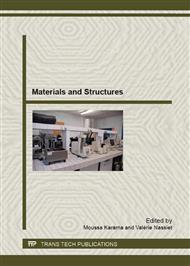[1]
G. Glinka, Residual stress in fatigue and fracture: Theoretical analyses and experiments. In Niku-Lari A., Editor, Advances in Surfaces Treatments, 413-454. Pergamon Press, (1987).
DOI: 10.1016/b978-0-08-034062-3.50029-x
Google Scholar
[2]
H. Mughrabi, Fatigue Behavior of Metallic Materials, D. Munz, Ed., DGM-Information sgesellschaftVerlag, Oberursel, 7-38, (1985).
Google Scholar
[3]
M. Truchon, Application of low-cycle fatigue test results to crack initiation from notches, low-cycle fatigue and life prediction, In: ASTM STP 770, C. Amzallag, B. N. Leis, and P. Rabbe, (Eds.), American Society for Testing and Materials (1982), p.254.
DOI: 10.1520/stp32432s
Google Scholar
[4]
G. Glinka, Engineering Fracture Mechanics, 21(2) (1985), p.245.
Google Scholar
[5]
D. F. Socie, Experimental Mechanics, 17 (1977), p.50.
Google Scholar
[6]
X. Zheng, Int. J. of Fatigue 23 (2001), p.751.
Google Scholar
[7]
Z. Khan, A. Rauf, M. Younas, J. Mat. Engng. Perfor. 6(3) (1977), p.365.
Google Scholar
[8]
M. Zheng, E. Niemi, X. Zheng, Theor. Appl. Fract. Mech. 26 (1997), p.23.
Google Scholar
[9]
F.J. McMaster, D.J. Smith, International Journal of Fatigue 23, S93–S101, (2001)
Google Scholar
[10]
C.A. Rodopoulos, J.H. Choi, E.R. De los Rios, J.R. Yates, Int. J. Fatigue 26 (2004) 747.
Google Scholar
[11]
M. Benachour, A. Hadjoui, M. Benguediab and N. Benachour. Stress ratio effect on fatigue behavior of aircraft aluminum alloy 2024 T351. In : MRS Proceedings, 1276, 7 (2010).
DOI: 10.1557/proc-1276-7
Google Scholar
[12]
P.J. Withers, H.K.D.H. Bhadeshia, Materials Sciences and Technology 17 (2001).
Google Scholar
[13]
C. Makabe, A. Purnowidodo A. A.J. McEvily, Int. J. of fatigue 26 (2004), p.1341.
Google Scholar
[14]
R. John, K.V. Jata, K. Sadananda, Int. J. of fatigue 25 (2003), p.939.
Google Scholar
[15]
J. Barralis, L. Castex, G. Maeder, Précontraintes et traitements superficiels, Technique de l'Ingénieur, traité matériaux métalliques M1 180.
DOI: 10.51257/a-v2-m1180
Google Scholar
[16]
T Fett, Engineering Fracture Mechanics 56 (1997), p.275.
Google Scholar
[17]
M. Beghini, L. Bertini, Engineering Fracture Mechanics, 36 (1990), p.379.
Google Scholar
[18]
S. Suresh, R.O. Ritchie, Materials Sciences and Engineering. 51 (1981), p.61.
Google Scholar
[19]
S. Kamel, Robert C. Wimpory, Michael Hofmann, Kamran M. Nikbin, N.P. O'Dowd, Advanced Materials Research, 89-91 (2010), p.275.
Google Scholar
[20]
A.N. Al-Khazraji, F.M. Mohammed, R. A. Al-Taie, Eng. Tech. Journal, 29(3) (2011).
Google Scholar
[21]
M. Zheng, J.H. Luo, X.W. Zhao, Z.Q. Bai, R.Wang , Int. J. Pres. Ves. Pip. 82 (2005), p.546.
Google Scholar
[22]
J.C. Grosskreutz, C.G Shaw, Critical mechanisms in the development of fatigue cracks in 2024 T4 aluminum, Proc. 2nd Int. Conf. on Fracture, Brighton (1969).
Google Scholar
[23]
N. Ranganathan, H. Aldroe, F. Lacroix, F. Chalon, R. Leroy, A. Tougui, Int. J. Fatigue 33 (2011), p.492.
DOI: 10.1016/j.ijfatigue.2010.09.007
Google Scholar
[24]
E. Tuegel, Strain-life crack initiation life software, provided by analytical processes and engineered solutions, (AP/ES) Inc., 1996.
Google Scholar
[25]
J.A Harter, AFGROW users guide and technical manual: AFGROW for Windows 2K/XP, Version 4.0011.14, Air Force Research Laboratory, 2006.
DOI: 10.21236/ada370431
Google Scholar
[26]
H. Neuber, Trans. ASME, Journal of Applied Mechanics (Dec 1960), p.544.
Google Scholar
[27]
L.F. Coffin, Transactions of the ASME, 76 (1954), p.931.
Google Scholar
[28]
J.C. Newman, International Journal of Fracture, 24(3), (1984), p.131.
Google Scholar


